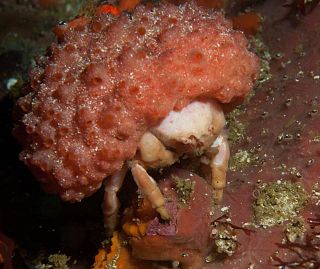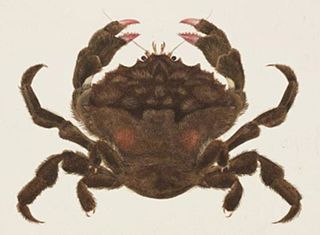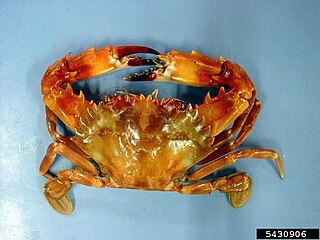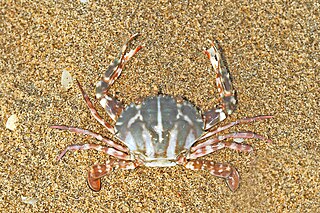Related Research Articles

The Japanese spider crab is a species of marine crab that lives in the waters around Japan. It has the largest leg span of any arthropod. They go through three main larval stages along with a prezoeal stage in order to grow to their great size. The genus Macrocheira contains multiple species. Two fossil species of this genus have been found, Macrocheira ginzanensis and Macrocheira yabei, both from the Miocene of Japan. The diverse taxonomic history is an important part of what these creatures are and how they evolved to be what they are today. These creatures are not isolated however, as they are the subject of fishery and are considered a delicacy. Conservation efforts are being put forth to protect these creatures and their population from the dangers of overfishing.

Notomithrax ursus, known as the hairy seaweed crab, is a spider crab of the family Majidae.

Dromia personata, also known as the sponge crab or sleepy crab, is a species of crab found in the North Sea, the Mediterranean Sea, and connecting parts of the northeastern Atlantic Ocean. Like most other epibenthic crustaceans, the biomass of this species is especially dense in the Mediterranean continental shelf. It mainly resides from the lower shore to a depth of 50 meters (164 ft), often in caves. Occasionally, they are found living in depths as low as 110 meters (360 ft). They serve as prey for octopus, starfish, and other fish. Their last two pairs of legs are positioned dorsally, and are used to hold a sponge in place as camouflage.

Dromia dormia, the sleepy sponge crab or common sponge crab, is the largest species of sponge crab. It grows to a carapace width of 20 cm (8 in) and lives in shallow waters across the Indo-Pacific region.

Nemanthus annamensis, commonly known as the gorgonian wrapper, is a species of sea anemone found in central Indo-Pacific waters.

Xantho hydrophilus, the furrowed crab or Montagu's crab, is a species of crab from the family Xanthidae. It is yellowish-brown and grows to a carapace width of 70 mm (2.8 in). It is a nocturnal Omnivore that lives in shallow marine waters from western Scotland to the Cape Verde Islands.

Lybia edmondsoni is a species of small crab in the family Xanthidae and is endemic to the Hawaiian Islands. Like other members of the genus Lybia, it is commonly known as the pom-pom crab or boxer crab because of its habit of carrying a sea anemone around in each of its claws, these resembling pom-poms or boxing gloves. Its Hawaiian name is kūmimi pua, meaning "inedible flower crab". In ancient times, this animal was used by men claiming to be sorcerers.

Oregonia gracilis, commonly known as the graceful decorator crab, is a species of crab belonging to the family Oregoniidae. Like other decorator crabs it habitually attaches other organisms to its back. The sessile organisms are attached to hooked setae that act as a sort of velcro attachment. This decoration provides visual and chemical camouflage thus reducing predation risk. Pacific halibut are a major predator of O. gracilis. Other predators include octopus and sea otters. The main food source of O. gracilis is floating kelp and algae that they capture utilizing a waiting strategy in order to maintain cryptosis.

Lybia tessellata is a species of small crab in the family Xanthidae. It is found in shallow parts of the tropical Indo-Pacific Ocean. Like other members of the genus Lybia, it is commonly known as the pom-pom crab or boxer crab because of its habit of carrying a sea anemone around in each of its claws, these resembling pom-poms or boxing gloves.

Oregonia bifurca, commonly known as the split-nose crab or the split-nose decorator crab, is a species of crabs belonging to the genus Oregonia. It is a rare deep-water species that inhabits the tops of seamounts and guyots in the northeastern Pacific Ocean; from the Aleutian Islands, the Bering Sea, the Hawaiian–Emperor seamount chain, to the waters off British Columbia. It is closely related to the more common shallow-water species Oregonia gracilis, the graceful decorator crab.
Mithraculus cinctimanus is a species of crab in the family Majidae. It is found in the Caribbean region and is usually associated with a sea anemone, sponge or coral.

Dorippe frascone, the urchin crab or carrier crab, is a small species of crab in the family Dorippidae that was first described scientifically by J.F.W. Herbst, in 1785. It is found in the Red Sea and parts of the western and eastern Indian Ocean. It often has a symbiotic relationship with a long-spined sea urchin and carries one around on its carapace.
Chaceon bicolor is a species of crab. Chaceon bicolor differs from all species of the genus in color pattern, with the anterior part of the body purplish rather than reddish. In addition to color pattern, C. bicolor also differs from C. granulatus in having compressed rather than depressed dactyli on the walking legs; also, the hepatic region of the carapace in C. granulatus is coarsely granular, whereas it is smooth in C. bicolor. Juvenile specimens differ from adults in many features: the teeth of the carapace are much larger and sharper, there is a sharp spine on the carpus of the cheliped and a distal spine on the merus of each walking leg, plus the legs are longer and slenderer. Adult females differ from males in having much sharper anterolateral teeth on the carapace, sharper suborbital spines, and much shorter legs, with less trace of a distal dorsal projection on the merus. The carapace of females is more strongly arched from front to back and the protogastric regions are noticeably more inflated. The species is named as such because of its colour patter, purple an tan.

The furred sponge crab, Pseudodromia latens, is a species of crab in the family Dromiidae, often referred to as sponge crabs.

Cyclocoeloma is a genus of crabs in the family Majidae, containing the single species Cyclocoeloma tuberculata.

Lauridromia is a genus of crabs in the family Dromiidae. It contains only two species. At one time a third species, Lauridromia indica, was included in the genus but that has now been transferred to the genus Dromidiopsis as Dromidiopsis indica.

Lauridromia dehaani is a species of crab in the family Dromiidae. It is native to the Red Sea and the western Indo-Pacific. It often carries a piece of sponge on its carapace by way of camouflage, and if unable to find a suitable piece of sponge, carries an empty bivalve shell, a sprig of seaweed or a piece of debris instead.

Charybdis hellerii, the Indo-Pacific swimming crab or spiny hands is a species of crab from the swimming crab family, the Portunidae. Its native range covers the Indian and Pacific Oceans but it has been introduced to the western Atlantic and has invaded the Mediterranean. It is a commercially exploited species in south-east Asia.
Notopus dorsipes is a species of frog crab from the family Raninidae which has an Indo-Pacific distribution and which has recently spread into the eastern Mediterranean. It is the only extant species in the genus Notopus.

Charybdis feriata, the crucifix crab, is a species of swimming crab in the family Portunidae. It is found in the tropical and subtropical Indo-Pacific region.
References
- 1 2 3 Peter Davie (2013). "Lauridromia intermedia (Laurie, 1906)". WoRMS. World Register of Marine Species . Retrieved February 6, 2014.
- 1 2 Chan, Tin-Yam. "Lauridromia intermedia (Laurie, 1906)". Biota Taiwanica. Archived from the original on June 21, 2015. Retrieved February 6, 2014.
- 1 2 3 4 Lavaleye, M.S.S.; den Hartog, J.C. (1995). "A case of associated occurrence of the crab Lauridromia intermedia (Laurie, 1906) (Crustacea: Decapoda: Dromiidae) and the actinian Nemanthus annamensis Carlgren, 1943 (Anthozoa: Actiniaria: Nemanthidae)". Zool. Med. Leiden. 69 (11): 121–130. ISSN 0024-0672.
- ↑ "Sponge crab: Family Dromiidae". Wild factsheets. WildSingapore. Retrieved 2014-02-09.